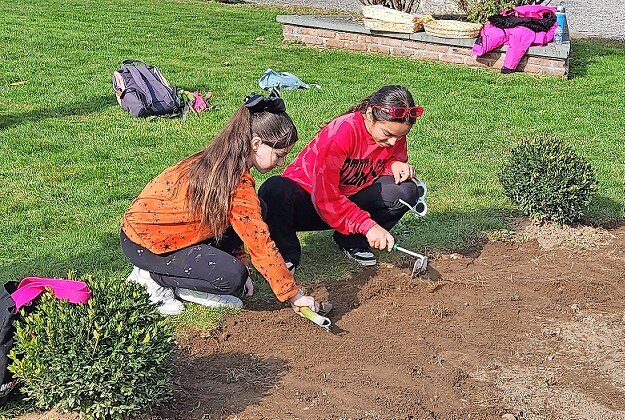In time of war, daffodils signal hope, community
The air outside the entrance to the Holocaust Memorial and Tolerance Center was filled with the sweet scent of freshly turned soil. Children and their families worked to carefully plant daffodil bulbs along the center’s entranceway, ensuring that every plant found its place in the soil to honor the Israeli lives lost during the Oct. 7 Hamas attacks which killed more than 1,200 people.
The event at the Glen Cove center was a joint effort with the Daffodil Project, an Atlanta based initiative of Am Yisrael Chai, a Holocaust education and genocide awareness organization. The Daffodil Project aims to create a living Holocaust memorial by planting 1.5 million daffodils around the world to remember and represent the one-and-a-half million children who died in Nazi occupied Europe. To date, more than 860,000 daffodils have been planted in 460 locations worldwide.
The project also seeks to memorialize the recent deaths in Israel, and bring awareness to the 400-percent increase in antisemetic incidents in the United States. New York alone accounted for 15.7 percent of all documented antisemitic incidents nation-wide in 2022.
“In the 29 years that we have been here, this is the first time that we need to have a police presence every single day,” said Jolanta Zamecka, vice-chair of the Holocaust center. “It is also the first time in those 29 years where people have canceled coming to today’s event because they’re afraid.”
Mojgan (Moji) Pourmoradi, the center’s director, recalled conversations she had with some of its members days after the Oct. 7 attack. Many who are the children of Holocaust survivors told Pourmoradi their parents cautioned them to always have a suitcase packed.
The advice has deep resonance and familiarity for Jews and has its roots in thousands of years of dislocation, begging the question: Where is it safe for Jews to go?
“It makes us feel like ‘never again’ was just something that we said, and nobody was listening,” Pourmoradi said. “It makes us feel Like everything changed in a day.”
Pourmoradi also noted the gathering coincided with Kristallnacht, when Nazis and their supporters destroyed Jewish homes, businesses, and synagogues across Germany from Nov. 9 to Nov. 10, 1938. Kristallnacht (Night of Broken Glass) was one of the first large-scale, open acts of violence the Nazi regime and their collaborators committed against Jewish Germans.
Alan Mindel, center chair, said the center has often confronted people who deny the Holocaust, and now will face those who deny the Oct. 7 attacks.
“The Holocaust center is here for many purposes,” Mindel said. “We stand for those that no one else will stand for.”
Originally, the Nazis made Jews wear a yellow star on their arms, a symbol of degradation, signaling that its wearers were less than fine, upstanding people, and eventually that they were less than human.
Daffodils are planted because the shape and color of the plant recalls those yellow stars, with yellow symbolizing remembrance. Daffodils represent a poignant hope for the future. They are resilient and return with a burst of color each spring, signifying hope, renewal, and beauty.
“The daffodils are resilient, and they come back every year, to remind us to take action, they remind us to think about what’s going on in the world today,” said Dr. Andrea Videlefsky, who launched the project in 2000.
Dr. Videlefsky said. “One daffodil on its own is a beautiful flower, but as these daffodils run together to emerge from the darkness of winter, you will see that many daffodils standing all together bring hope, light and beauty — and a communal strength — as we remember the children and remind ourselves to take action.”
“It’s more important than ever, for each of us to stand up against injustice,” Videlefsky said. “The world vowed ‘never again,’ and here we are facing this enormous tragedy.”






